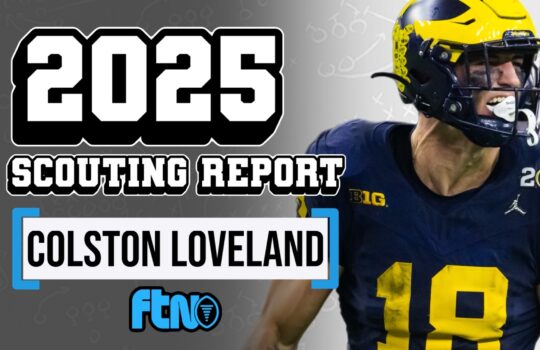
Every Monday, I find myself in a bit of NFL data purgatory. We’re waiting for the week to come to a proper ending, and the data is still yet to be finalized. It’s a great time, however, to look at some historical trends and do some digging on some things we can leverage in the upcoming week. This piece will be out on Tuesdays, but it won’t have the same format or topic each week. The formula will change as I poke around with the data we have access to here. It’ll just be my musings on something that caught my eye. If there’s something to it, I’ll give you some way to leverage the conclusions in fantasy for the upcoming week.
Is it possible to be “too close” to the end zone?
In keeping with the theme of looking into things announcers (or maybe your uncles) say during football games, we’re going to see what happens once a team is close to the end zone. There’s a recurring idea that there’s not enough space for teams to pass once they’re inside the red zone. It got me thinking about how teams are able to set up their offense as space gets limited and what they should be prioritizing.
I put up a Twitter poll that asked if the respondent would rather have:
- First-and-10 from the opponent’s 12
- First-and-goal from the opponent’s 8
The results were 70-30 in favor of getting the ball at the opponent’s 8 rather than the 12. There are logical reasons for wanting either. A first-and-10 from a bit further out gives you an extra chance at a first down, which could allow you to call plays differently and might even lead to more fourth-down attempts. A first-and-goal from just inside the 10 is closer and therefore offers a higher probability of scoring a touchdown.
In a vacuum, then, you’d think the case is closed. Teams should always prefer scenarios with higher scoring probabilities and therefore a first-and-10 from just inside the 10-yard line should be the preferred option. But, what happens during that first-down play is important as well.
What do teams do when they’re close to the goal line?
On first-and-10 in this area of the field, teams run. They run a lot. Teams are slightly more pass-heavy when they’re outside of the 10, compared to just inside of the 10.
We know – from a macro perspective, at least – that passing is generally better than rushing. It makes intuitive sense that teams are slightly more likely to pass on first down.
When are teams more successful?
If we break down the categories so that it reflects the yard line of the offense and their play call on first down, we can hone in on how a team’s decision changes things.
When teams are just outside the 10, passing is the better option by a fair margin. Once they get inside the 10, the logic flips and they’re better off running. There’s also the risk of turnovers. Whether it’s just inside or outside of the 10, the turnover rates are higher on passes than on runs, which makes intuitive sense.
Overall, though, teams are still more likely to score a touchdown on a pass inside the 15 until they get to about the 3-yard line. So, while teams are willing to start off with a run, they’re still more likely to find the end zone with a pass. It seems that the opponent’s 3-yard line is where teams actually run out of room, rather than immediately once they enter the red zone.
















































 New York Jets
New York Jets  New England Patriots
New England Patriots  Miami Dolphins
Miami Dolphins  Buffalo Bills
Buffalo Bills  Pittsburgh Steelers
Pittsburgh Steelers  Cleveland Browns
Cleveland Browns  Cincinnati Bengals
Cincinnati Bengals  Baltimore Ravens
Baltimore Ravens  Tennessee Titans
Tennessee Titans  Jacksonville Jaguars
Jacksonville Jaguars  Indianapolis Colts
Indianapolis Colts  Houston Texans
Houston Texans  Las Vegas Raiders
Las Vegas Raiders  Los Angeles Chargers
Los Angeles Chargers  Kansas City Chiefs
Kansas City Chiefs  Denver Broncos
Denver Broncos  Washington Commanders
Washington Commanders  Philadelphia Eagles
Philadelphia Eagles  New York Giants
New York Giants  Dallas Cowboys
Dallas Cowboys  Minnesota Vikings
Minnesota Vikings  Green Bay Packers
Green Bay Packers  Detroit Lions
Detroit Lions  Chicago Bears
Chicago Bears  Tampa Bay Buccaneers
Tampa Bay Buccaneers  New Orleans Saints
New Orleans Saints  Carolina Panthers
Carolina Panthers  Atlanta Falcons
Atlanta Falcons  San Francisco 49ers
San Francisco 49ers  Seattle Seahawks
Seattle Seahawks  Los Angeles Rams
Los Angeles Rams  Arizona Cardinals
Arizona Cardinals 










 Boston Celtics
Boston Celtics  Brooklyn Nets
Brooklyn Nets  Philadelphia 76ers
Philadelphia 76ers  New York Knicks
New York Knicks  Toronto Raptors
Toronto Raptors  Chicago Bulls
Chicago Bulls  Detroit Pistons
Detroit Pistons  Milwaukee Bucks
Milwaukee Bucks  Cleveland Cavaliers
Cleveland Cavaliers  Indiana Pacers
Indiana Pacers  Orlando Magic
Orlando Magic  Atlanta Hawks
Atlanta Hawks  Charlotte Hornets
Charlotte Hornets  Miami Heat
Miami Heat  Washington Wizards
Washington Wizards  Denver Nuggets
Denver Nuggets  Minnesota Timberwolves
Minnesota Timberwolves  Oklahoma City Thunder
Oklahoma City Thunder  Portland Trail Blazers
Portland Trail Blazers  Utah Jazz
Utah Jazz  LA Clippers
LA Clippers  Golden State Warriors
Golden State Warriors  Los Angeles Lakers
Los Angeles Lakers  Phoenix Suns
Phoenix Suns  Sacramento Kings
Sacramento Kings  Dallas Mavericks
Dallas Mavericks  Houston Rockets
Houston Rockets  Memphis Grizzlies
Memphis Grizzlies  New Orleans Pelicans
New Orleans Pelicans  San Antonio Spurs
San Antonio Spurs 









